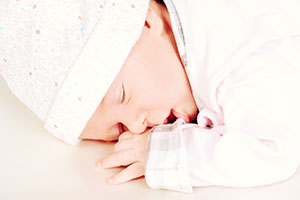Safety alert! When traveling, many parents put their infants to bed in unsafe positions or locations, increasing the risk of SIDS (sudden infant death syndrome) and other injuries.

1. Safe sleeping arrangements are often difficult to duplicate away from home. Until infants are one year of age they should be put to bed on their backs on a fairly hard surface with no nearby toys or bumpers, says the American Academy of Pediatrics (AAP).
2. No exceptions to these rules. Not for one night. Not for short naps. Not if the child wakes up at night – which may occur more often away from home. When infants wake up at night, parents tend to make practical rather than sound decisions as to how to get the infant back to sleep, says the AAP. Advise baby sitters to follow the rules. One in five infants who experiences SIDS was in the care of someone other than a parent.
 3. Never “co-sleep.” Infants sleeping in bed with adults have been injured when an adult rolled onto them or the infant fell off the bed – no matter how ingeniously adults tried to prevent problems. Breathing issues may occur when infants bury their heads into pillows, comforters and loose bed linen. Also, co-sleeping when traveling may make it difficult to get infants to sleep alone upon returning home.
3. Never “co-sleep.” Infants sleeping in bed with adults have been injured when an adult rolled onto them or the infant fell off the bed – no matter how ingeniously adults tried to prevent problems. Breathing issues may occur when infants bury their heads into pillows, comforters and loose bed linen. Also, co-sleeping when traveling may make it difficult to get infants to sleep alone upon returning home.
 4. Car seats are not for overnight sleeping. Infants sleep well in car seats but should never be left unattended in them. Problems that have occurred include compromised airways when the infant’s head flops onto its chest, entanglement in straps wrongly applied, and falling out of seats. Many car seats are unstable unless properly strapped into cars. (Also, infants should not sleep unattended on sofas, recliners, bouncy chairs or swings.)
4. Car seats are not for overnight sleeping. Infants sleep well in car seats but should never be left unattended in them. Problems that have occurred include compromised airways when the infant’s head flops onto its chest, entanglement in straps wrongly applied, and falling out of seats. Many car seats are unstable unless properly strapped into cars. (Also, infants should not sleep unattended on sofas, recliners, bouncy chairs or swings.)
 5. Check cribs for safety in hotels and when visiting friends and relatives. Cribs should look new and have firm, tight-fitting mattresses (two fingers should not fit between the edge of the mattress and the side of the crib; a 12-ounce soda can should not fit between slats). Cribs should not have protruding parts, screws, bolts or cutouts in the head or footboard, which can trap an infant’s head or limb. Cribs with sides that slide up and down are no longer considered safe. If possible, check whether cribs have been recalled by the manufacturer for being unsafe. Recalls occur almost yearly.
5. Check cribs for safety in hotels and when visiting friends and relatives. Cribs should look new and have firm, tight-fitting mattresses (two fingers should not fit between the edge of the mattress and the side of the crib; a 12-ounce soda can should not fit between slats). Cribs should not have protruding parts, screws, bolts or cutouts in the head or footboard, which can trap an infant’s head or limb. Cribs with sides that slide up and down are no longer considered safe. If possible, check whether cribs have been recalled by the manufacturer for being unsafe. Recalls occur almost yearly.
 6. “Heirloom” cribs and cradles may not meet current safety specifications. Stringent upgrades in crib design went into effect in 1970 and again in 2000. Very old cribs may have been painted with lead-containing paints. Cradles are popular overseas. While they are quaint, infants in cradles can roll so far to one side that the cradle topples over. Most cradles have pins to prevent this but the pins may be broken or missing.
6. “Heirloom” cribs and cradles may not meet current safety specifications. Stringent upgrades in crib design went into effect in 1970 and again in 2000. Very old cribs may have been painted with lead-containing paints. Cradles are popular overseas. While they are quaint, infants in cradles can roll so far to one side that the cradle topples over. Most cradles have pins to prevent this but the pins may be broken or missing.
7. Place cribs in safe locations. For older infants, avoid areas near window blinds, shades and drapes to prevent strangulation, and away from furniture that can make it easier for the infant to climb out. Place cribs either flush against the wall or several feet from the wall so that if infants do climb out they will not become wedged between the wall and the crib. Place pillows on the floor around the crib, just in case. Secure wheels.
 8. On flights, try not to fall asleep with an infant on your lap. Infants have slipped off laps, landing on the floor and, very rarely, suffocated when a parent’s sleeping body rested over the child’s face. Safety officials recommend using an airline-approved safety seat. Some car seats serve this purpose but few parents use them. The seats are clumsy to carry and may require paying an extra fare.
8. On flights, try not to fall asleep with an infant on your lap. Infants have slipped off laps, landing on the floor and, very rarely, suffocated when a parent’s sleeping body rested over the child’s face. Safety officials recommend using an airline-approved safety seat. Some car seats serve this purpose but few parents use them. The seats are clumsy to carry and may require paying an extra fare.
 9. Buy a portable travel crib.They’re very handy for car trips, can be used outdoors, are lightweight, fold easily and compactly, are easy to clean, and have not been used by others. Some are specific for infants of certain heights and weights and constructed so that older infants cannot easily climb out. Learn how to assemble and disassemble it. Have infants sleep in a portable crib for a week before leaving home.
9. Buy a portable travel crib.They’re very handy for car trips, can be used outdoors, are lightweight, fold easily and compactly, are easy to clean, and have not been used by others. Some are specific for infants of certain heights and weights and constructed so that older infants cannot easily climb out. Learn how to assemble and disassemble it. Have infants sleep in a portable crib for a week before leaving home.
10. Miscellaneous. Don’t medicate. Some sedating medications (antihistamines, for example) may make infants sleep less, as well as having other side effects. Take along your infants’ blankets, sheets and pajamas. Familiar textures and odors seem to make infants more comfortable. Don’t overdress them. Keep rooms on the cool side. Air conditioning does not cause illness. Ask hosts not to smoke. While travel necessitates change, try to follow home feeding/napping/going outdoors/bathing schedules. Avoid keeping infants awake for evening get-togethers and such. Products that claim to reduce the risk of SIDS (wedges, positioners, special mattresses, and specialized sleep surfaces) are not effective.

